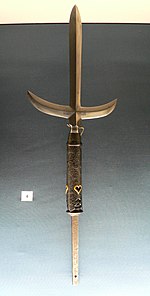Yari
| Yari | |
|---|---|

|
|
| Information | |
| Weapon type: | lance |
| Use: | Weapon, traditional weapon |
| Creation time: | approx. 16th century |
| Working time: | til today |
| Region of origin / author: |
Japan , samurai |
| Distribution: | Japan , today worldwide |
| Overall length: | approx. 240 cm |
| Blade length: | approx. 14 cm - approx. 60 cm |
| Handle: | Wood, horn, lacquer |
| Particularities: | different blade shapes |
| Lists on the subject | |
The Yari ( Japanese 鎗 , also 槍 or 鑓 ) is a Japanese lance with a long nakago (tang).
description
The length of the blade varies between 15 cm and more than 60 cm. The shaft was up to 240 cm long. Most of the larger Yari were forged like Nihonto made of laminated steel and partially hardened. The shaft is usually lacquered, sometimes the Saya . As with swords, metal fittings and decorative inlays (mother-of-pearl, eggshells and ray skin) could also be used here. In addition to the long sword katana , the yari was considered to be the most effective weapon in close combat during battle , especially for the ashigaru (foot soldiers). It was also used by the samurai and, similar to the Naginata , had its greatest advantages in fighting mounted and armored opponents. The yari was only used in close combat and was not thrown (difference between lance and spear).
Types and naming
The names differ in many ways. There are main groups that are named differently in different versions. There are different types of blades, for example:
- Sankaku Yari
- Standard shape, straight blade, in widely varying lengths, triangular cross-section, two parallel cutting edges. Often with BOHI (fuller) on the flat side
- Hoko
- Blade straight, leaf-shaped. Early version of the yari
- Fukuro Yari
- mostly short, straight, double-edged blade; not a tang, but a spout.
- Omi Yari
- Blade straight, long and double-edged.
- Sasaho Yari
- Blade in the shape of a broad bamboo leaf. Straight, triangular cross-section, double-edged.
- Futamata Yari
- Blade straight, wide, the same width from the shaft to the location, shaft with cross-guard.
- Katagama Yari
- Two blades, one straight blade with two edges, the second blade bending at right angles just before the shaft, blade straight and two edges.
- Two blades, one straight, double-edged and leaf-shaped, the second double-edged blade, bent at right angles just before the shaft, bent in place and longer than the first blade.
- Two blades, one straight and very short, bolt-shaped, slightly pointed, second blade bending at a right angle just before the shaft, blade straight and wedge-shaped, much longer than blade one.
- Jumonji-Yari ( 十 文字 槍 ), also called Magari Yari.
- Three blades, T-shaped, first blade straight and double-edged, second and third blade turning to the right and left just behind the handle, both straight and double-edged.
- Three blades, T-shaped, first blade straight and double-edged, second and third blade bending to the right and left just before the handle, similar to a lying s.
- Three blades, T-shaped, first blade straight and double-edged, second and third blade bending to the right and left just before the handle, blades slightly curved and hook-shaped at the end.
- Three blades, T-shaped, first blade straight and double-edged, second and third blade bending to the right and left shortly before the handle, short and blunt.
- Three blades, T-shaped, first blade straight and double-edged, second and third blade bending to the right and left shortly before the handle, double-edged and crescent-shaped.
- Kagi Yari
- A blade that is bent at a right angle at the front end ( location ). Place beveled, double-edged.
- Yajiri nari Yari
- The blade is double-edged and has the shape of a Japanese arrowhead ( Yanone ).
- Kikuchi Yari
- Blade in the shape of a Japanese tanto or knife blade. Double-edged. Normal cutting edge and about a third of the back of the blade from the place to the handle .
- Zuki nari Yari
- Blade crescent-shaped, sharp in the concave area pointing forward.
- Chidori Jumonji Yari
- Three blades. The middle, long blade is leaf-shaped and becomes narrower from the handle to the location and wider again near the location. Cross-shaped, crescent-shaped side blades to the right and left of the central blade. The area facing the location is sharp, as are the sides of the blades facing the end of the shaft. Towards the end of the shaft, the side blades are shaped like a bat's wing (see gallery).
This list does not claim to be complete. In total there are over 700 versions, which are named differently and contain differently shaped blades.
Blade shapes (cross section)
Individual evidence
- ↑ George Cameron Stone , Donald J. LaRocca: A Glossary of the Construction, Decoration and Use of Arms and Armor: in All Countries and in All Times. Courier Dover Publications, 1999, ISBN 978-0-486-40726-5 (Reprint), p. 674 f.
- ^ Daniel C. Pauley: Pauley's Guide - A Dictionary of Japanese Martial Arts and Culture. Samantha Pauley Verlag, ISBN 978-0-615-23356-7 , p. 197.
- ↑ Stephen R. Turnbull: Warriors of medieval Japan. Verlag Osprey Publishing, 2005, ISBN 978-1-84176-864-9 , pp. 162, 35.
- ↑ Roald Knutsen, Patricia Knutsen: Japanese spears: polearms and their use in Old Japan. Global Oriental publishing house, 2004, ISBN 978-1-901903-56-0 .









